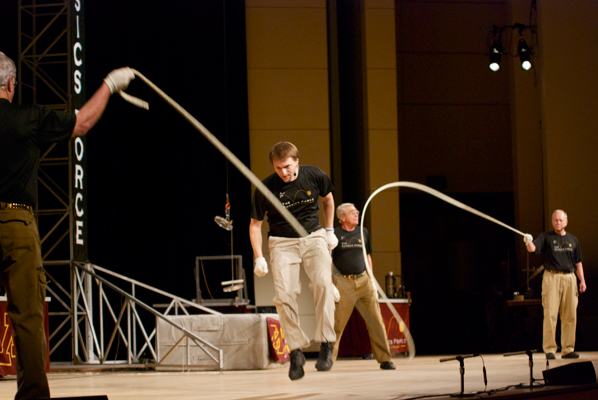What Happens
During this demonstration you will see members of the Physics Force jumping rope and explaining the mechanics of waves.
How it Happens
Any time waves from different sources to cross each other they will add together. This addition will produce places where the waves are large in size as well as places where the addition produces minimums, or even no wave. A simple way to demonstrate this is to wiggle a rope, sending a series of waves down the rope and let them reflect off the other end. The reflected waves that are returning act as a second source that will cross the newly generated incoming waves and wave interference results. If you play with the rhythm (frequency) that you produce, the waves will hit several situations where the quiet spots (nodes) and the large waving spots (anti-nodes) remain in fixed positions. This phenomenon is called a standing wave.
The production of standing waves is very important in the operation of musical instruments. The sound played on a string of a violin enters the wooden resonant chamber to establish a standing wave. The odd shape and size of the chamber allows for at least one dimension to establish a standing wave for every note the instrument can play. In just a few vibrations of the string the standing wave becomes large and strong able to produce full rich sound to be heard across the room.
Singing in the shower, a voice becomes full, powerful and rich on certain notes because the dimensions of the small room produces a standing wave. In a normal sized bathroom, it is more likely that a deeper voice will form a standing wave than a higher voice.
On occasion you can see a standing wave in high line wires and in the radio antenna of cars. The high line wires establish a standing wave during wind storms. There is usually a node in the middle and two anti nodes nearer the poles. When a car with a large engine idles, the vibrations of the motor can produce a standing wave in the radio antenna.
Vocabulary
Standing wave: vibration of a system in which some particular points remain fixed while others between them vibrate with the maximum amplitude.
Frequency: the rate at which a vibration occurs that constitutes a wave, either in a material (as in sound waves), or in an electromagnetic field (as in radio waves and light), usually measured per second.
Node: a point at which lines or pathways intersect or branch; a central or connecting point.
Antinode: the position of maximum displacement in a standing wave system.
